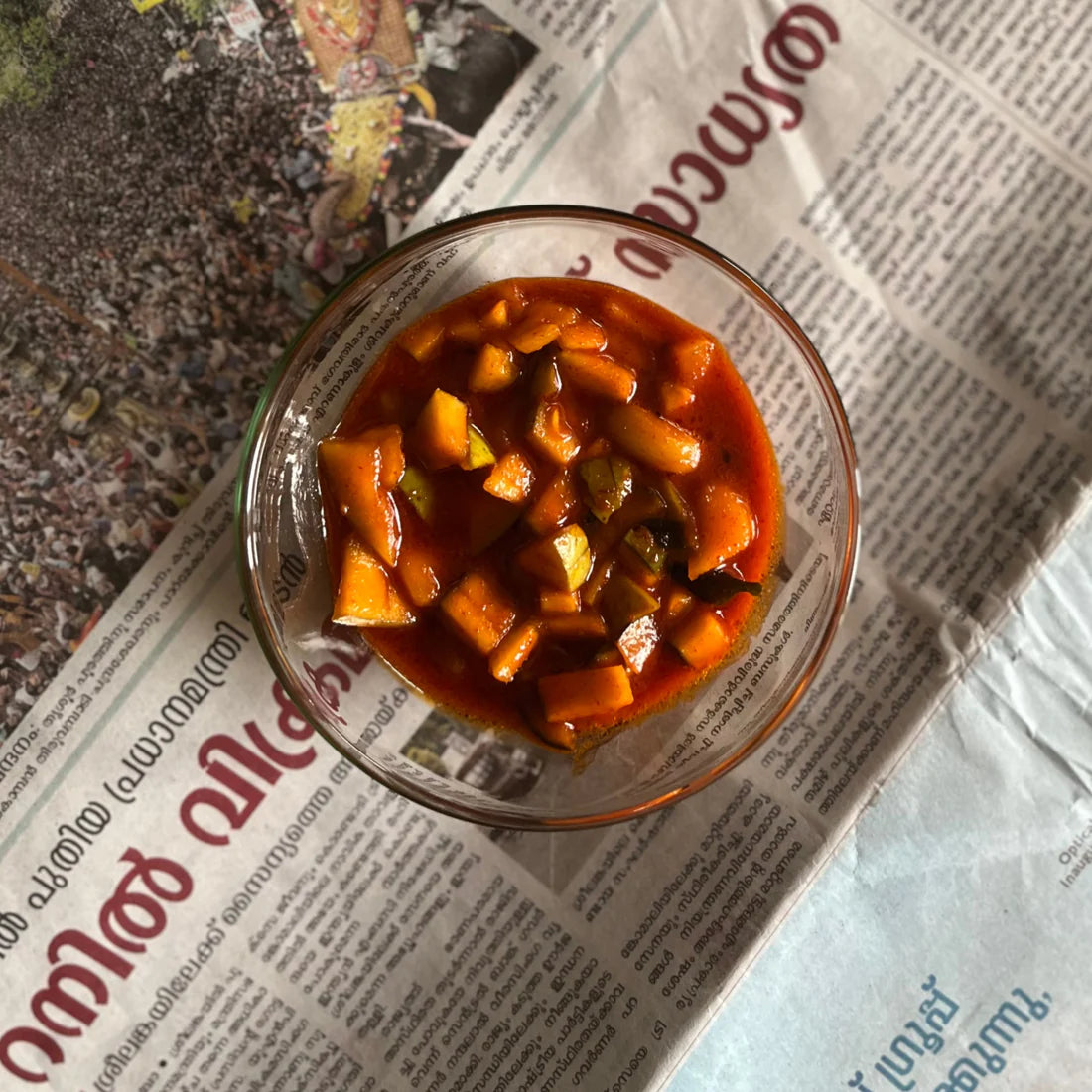
Cut Mango Pickle: Preserving the Tangy Delight of Summers
Share
Summer brings a double dose of excitement – vacations and mango season. The sight of plump mangoes gleaming in the sun and their aroma filling the air heralds the start of mango season. Kitchens get busy with preparations to make various mango varieties for family and friends, with mango pickle being a highly coveted choice. Beyond its role as a condiment, this pickle celebrates tradition and the art of preservation cherished in homes for generations. There are numerous methods for making mango pickle, each offering unique flavors and techniques. Let’s uncover the layers of flavor, explore the history, and understand why Cut Mango Pickle is more than just a side dish—it’s an enriching journey in every jar.
History of Mango Pickle
Mango pickling is an age-old craft deeply rooted in Indian homes, especially in Kerala and other southern regions. This ancient practice, ingrained in family recipes, served not only to preserve seasonal abundance but also as a tradition passed down through generations.
In times when refrigeration was a luxury, people ingeniously ensured their favorite mangoes were always available by transforming raw, green mangoes into a delectable pickle capable of withstanding time. Sliced into pieces and combined with a variety of spices, these mangoes underwent a transformation into a tangy, spicy delicacy. As summer days waned, jars of cut mango pickle proudly adorned pantry shelves, carrying not just the fruit’s essence but also the warmth of familial connections.
Same, Yet Uniquely Different
The methods of making mango pickle vary greatly across India. Travelling from the north to the south reveals diverse preparations distinguished by choice of oil, cutting styles, spice levels, gravy thickness, and more. In northern and northwestern India, pickles typically feature mustard oil, seen in Aam ka Achaar and Gujarati Methia Keri. Southern varieties like Andhra’s Avakaya and Kerala’s Kadumanga or nurumanga achaar favor gingelly or sesame oil. Beyond oil selection, regional spices play a crucial role in defining each pickle’s distinct flavor profile. Some variations, such as Gujarati and Goan styles, incorporate a hint of sweetness from jaggery or sugar. Most mango pickles use firm raw mangoes, but specific varieties like Kerala’s kannimanga achaar use young, tender mangoes harvested early in the season, offering an intense flavor that harmonizes perfectly with the added spices.
Every household presents a unique mango pickle recipe handed down through generations, each accompanied by its own set of cherished stories.
Crafting the Perfect Cut Mango Pickle

While methods vary, certain key spices are essential in mango pickle preparation alongside regional variations. It all begins with selecting raw, green mangoes—the star ingredient. After washing and carefully slicing them into bite-sized pieces, mangoes are set aside to reduce excess moisture. A spice blend of mustard seeds, fenugreek, asafoetida, and red chilies is prepared, coating each mango slice in a rich amalgamation of flavors. A final drizzle of gingelly or mustard oil enriches and binds the flavors into a harmonious blend. The jar is then sealed, allowing the pickle to mature into a culinary masterpiece. Each family’s preparation method adds a unique touch to this timeless delight, making it a fascinating culinary journey.
Pairing Possibilities
Cut Mango Pickle transcends its role as a mere condiment, enhancing a variety of dishes. It complements piping hot parathas for a burst of tangy goodness and adds depth to rice or dal with just a spoonful. It elevates sandwiches from ordinary to extraordinary and pairs delightfully with dosa or idli, providing a crunchy contrast to their textures. From curries to snacks, Cut Mango Pickle effortlessly transforms everyday meals into exceptional culinary experiences. For an extra comfort, I enjoy it alongside kanji (Kerala-style porridge) and chammanthi on a weary or sick day.
Health Benefits of Cut Mango Pickle
Rich in antioxidants from raw mangoes, this pickle supports immune health and provides essential vitamins. Fenugreek aids digestion, while mustard seeds contribute healthy fats and minerals. The fermentation process in homemade versions introduces gut-friendly probiotics, promoting digestive well-being. Homemade Cut Mango Pickle ensures controlled salt usage and avoids artificial preservatives, highlighting the wholesome goodness of natural ingredients. As with any food, moderation is key to enjoying its benefits.
Crafting Cut Mango Pickle is more than following a recipe; it’s a cherished ritual. Whether savored with a simple meal or part of a grand feast, each spoonful honors tradition. Indulge not only in its taste but in the stories woven into each jar a testament to the enduring charm of this timeless delight.
